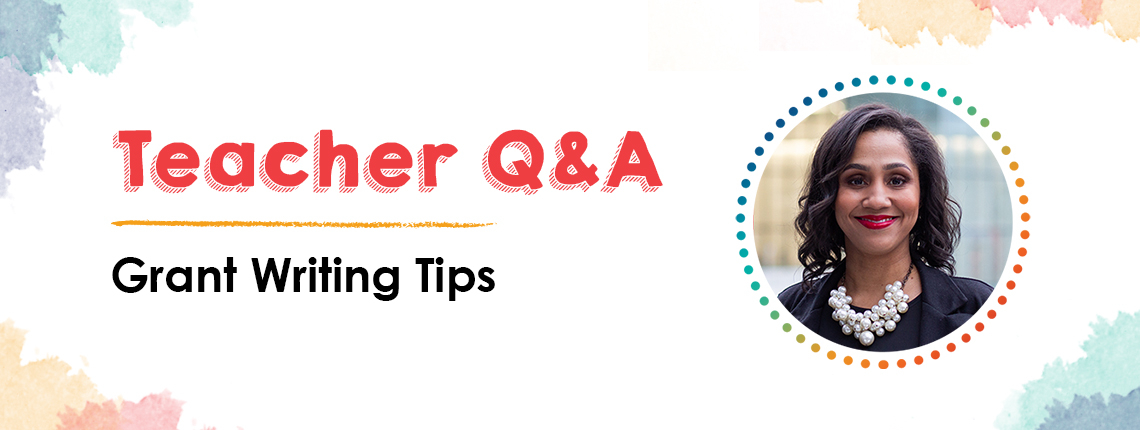Through AdoptAClassroom.org and other websites, teachers are often asked to write grants for the classroom items they need. Former teacher and grant writing expert Bejanae Kareem of BK International Education Consultancy explains how writing grants helped her when she was teaching and gives her teacher grant writing tips.
AdoptAClassroom.org (AAC): What is your background as a teacher?
Bejanae Kareem (BK): I served as a classroom teacher for over 10 years. I recall using personal funds to support classroom learning on many occasions. Additionally, I incorporated project-based learning to enhance the curriculum with authentic, real-world experiences. As a result, costs quickly added up. This motivated me to write grants to cover these growing costs. During the course of two years, I was awarded over $4,000 in classroom grants. This inspired me to support other educators in learning the science of grant writing to increase educational supports for children.
AAC: What made you want to start your own business to help support teachers?
BK: When teachers use high-quality instructional tools, students thrive!
I launched BK International Education Consultancy to advocate for and build educator capacity through training and coaching. We offer a range of professional learning from Creating Accessible Learning Environments, Expanding Classrooms through Virtual Field Trips, and Grant Writing for Teachers. By empowering educators to write classroom grants, teachers save more than $700 annually on classroom expenses and acquire high-quality instructional tools for onsite and remote learning.
AAC: One of the goals of your work is to help students become critical thinkers. Why is that important?
BK: Critical thinking is a key life skill that is essential for students to be good decision-makers and productive citizens. We show teachers how to increase instructional rigor using a culturally-responsive approach with the inclusion of real-world, high-cognitive tasks. Not only does this promote student critical thinking, but it also enhances collaboration, communication, and creativity.
AAC: How do you think teachers benefit from applying for classroom grants?
BK: Over 94% of U.S. public school teachers use personal funds to purchase instructional supplies to supplement student learning, according to the U.S. Department of Education (2018). A recent study by AdoptAClassroom.org, showed an increase of teacher spending to 97%, an average of $745 annually (2020). As a result, teachers encounter financial strain from these personal investments in an industry that is typically low-paying.
Grants can cover supplies, books, technology, and even professional development. Equipping teachers with guidance, resources, and tools to develop grant writing skills to fund classroom supplies and projects help strengthen support for student onsite or remote learning and alleviate the financial strain of personal investments of our nation’s essential workers.
AAC: What are your three teacher grant writing tips?
BK: Here are three tips to consider if you are writing your first classroom grant.
1. Identify students’ needs.
Grants are typically based on the needs of a target group. For a teacher, your target group is your students. Consider the following questions to identify the student needs that will be served by the classroom grant:
- What are the needs of your students? Are they academic? Social-emotional? Materials and supplies?
- What data (quantitative, qualitative, or anecdotal) do you have to demonstrate that these are needs?
2. Start with crowdfunding.
Once you have compiled and analyzed data to identify your students’ needs for a potential grant, it is time to find funding. Crowdfunding is the practice of funding a project via the internet by raising many small amounts of money from a number of people. Donation-based crowdfunding, similar to grants, does not have to be paid back. Educator donation-based crowdfunding sites such as AdoptAClassroom.org provide teachers with the opportunity to post their classroom needs online and attract public crowdfunders. This is a great place to start practicing your grant writing skills.
3. Follow the directions.
Before submitting your classroom grant proposal, be sure to take the following into account.
- Review all proposal instructions and follow them precisely
- Answer each proposal section/question explicitly
- Read the terms and conditions for each crowdfunding site
- Get school administrator approval to submit
- Have a third party proofread your proposal for clarity and grammatical errors
- Don’t wait until the last minute!
AAC: Any other advice for teachers during 2020, whether they’re teaching at home or in the classroom?
BK: During these unprecedented times, I recommend using this time to learn a new skill to enhance instruction whether teaching at home or in the classroom. Grant writing is a much-needed skill for teachers’ toolboxes and a great way to end personal spending in the classroom.
Follow BK Consultancy on Instagram for more grant writing tips for teachers.
For more funding opportunities for teachers, read more about the AdoptAClassroom.org Teacher Program here or register your classroom. You’ll be eligible for funding on AdoptAClassroom.org immediately and you’ll receive updates when teacher grant applications open.
